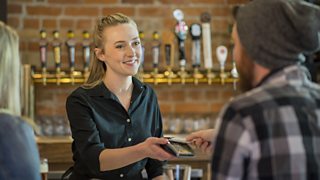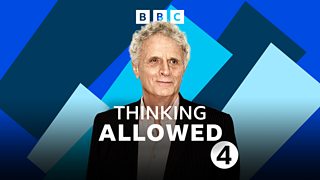Is no and low-alcohol beer better for you than a regular pint?
In the last five years, the sales of alcohol-free beers have tripled in the UK. But are these beers better for you than regular beer?
For BBC Radio 4's Sliced Bread, listener Stuart wants presenter Greg Foot to dig deeper into the health benefits of no and low-alcohol beer. He also looks at why non-alcoholic beers often cost the same as – or sometimes more than – their alcoholic counterparts.
In order to quench his thirst for this knowledge, Greg speaks to two experts in this area: Laura Willoughby, the co-founder of the mindful drinking organisation Club Soda, and Kerry Torrens, a registered nutritionist. Here's what Greg found out…

Even 'alcohol-free' beer contains some alcohol
In the UK, there are currently no laws on the alcoholic content of low and no-alcohol beers, simply guidelines. 'Alcohol free' is applied to any beverage that is up to 0.05% abv (alcohol by volume). "So even those cans that say 0% are probably up to 0.05% abv," advises Laura Willoughby.

Anything that has a fermentation process can have an alcoholic content.
Meanwhile, 'dealcoholised' beer applies to anything up to 0.5% abv, and it's not uncommon to see both 'alcohol free' and '0.5%' on a product. "0.5% is considered alcohol free nearly the rest of the world over," notes Laura.
Finally, 'low alcohol' is used for drinks with no more than 1.2% abv.
Even bananas can be 0.5% abv
To illustrate just how low 0.5% abv is, Laura points out that anything that has a fermentation process can have an alcoholic content and, depending on how ripe it is, a banana can be 0.5% abv. Vinegar can reach 0.3%, some ginger beers can be above 0.5%; soy sauces range between 1.5% and 2%.
Alcohol-free beer can be more expensive than regular beer
Even though there's duty on alcohol, non-alcoholic beers can often be the same price or slightly less expensive than regular beers, and some from smaller producers are actually more expensive.
According to Laura, it costs more to produce an alcohol-free beer because it involves more processes, more technology, more time and more ingredients to produce them. One of the reasons there are more processes is that alcohol is a natural preservative, so alcohol-free options undergo more treatment to make sure they are free of contaminants.
There's an economy of scale in play too, with non-alcoholic beer still a minority drink compared to regular beer.
You can't get drunk on alcohol-free beer
Given the statistics on bananas, it probably won't be a surprise that you can't get drunk on any non-alcoholic drink up to 0.5% abv. "You're more likely to drown first," quips Laura. She references a German study where participants drank 1.5 litres of 0.4% abv beer each. When their blood samples were analysed, the traces of alcohol were 100 times lower that the legal drink drive limit.
You still have to show ID to buy alcohol-free beers
Supermarkets and pubs have not made a distinction between alcohol-free and alcohol where ID is concerned. This is because both beverage types are strictly aimed at adults, and so supermarkets will stock non-alcoholic drinks next to their alcoholic equivalents. "Everyone's quite relaxed about there being age ID if it's a tiny inconvenience in the supermarket," Laura Willoughby says. She adds that, in pubs, if police are checking what is being served to who, they would have a much more complicated job if ID rules were different.

Despite the sugars, there are still more calories in alcoholic beers.
Some people worry that non-alcoholic options encourage people to drink alcohol
Greg asks Laura if she thinks that drinking non-alcoholic drinks in addition to alcoholic drinks – to reduce alcohol consumption overall – might, ultimately, have the opposite effect?
Laura says that the evidence suggests that the vast majority of drinkers of alcohol-free drinks just want to reduce their consumption, citing a study of 2,000 such drinkers that revealed this as the main reason for 72% of them.
Non-alcoholic beers can have extra sugar in them
In addition to grain (eg. barley), hops, water and yeast (specifically 'lazy yeast' in non-alcoholic versions), some non-alcoholic beers can have natural sugars in them such as lactose and fructose. These are sometimes added so that non-alcoholic beers can match the taste of the alcoholic ones.
Despite the sugars, there are still more calories in alcoholic beers because, as nutritionist Kerry Torrens notes, "alcohol actually contains more calories than sugar, with a gram of alcohol contributing seven calories and a gram of sugar contributing four calories."
Excess alcohol consumption can lead to a wide range of diseases
Using low or no-alcohol drink options to either avoid alcohol or to stay within the recommended intake of 14 units of alcohol a week (equivalent to six pints of 4% beer) could mean lowering the risk of stroke, heart disease, liver disease, sleep disorders, mental health issues and a number of cancers.
You should still drink non-alcoholic drinks with care
"A low to moderate intake of no alcohol beer is still something that's recommended," advises Kerry, and she singles out two groups of people who might want to avoid non-alcoholic options altogether: those who are pregnant ("there's no clear evidence as to what the safe dose of alcohol is in pregnancy") and those who have suffered from an alcohol dependency, because "even the smallest amounts of alcohol may trigger a relapse".

Some non-alcoholic beers are better than water for rehydrating after exercise
Greg remarks that when he has finished running a long race, he has been given a bottle or can of alcohol free Erdinger beer. This is because the minerals, salts and carbohydrates in some non-alcoholic beers give the drink isotonic properties, meaning that the liquid is closer in make-up to our own body fluid than water is and therefore, Kerry says, "our cells are more efficient at taking up that fluid and replacing what we've lost."
All beers contain polyphenols
Polyphenols, naturally occurring and anti-inflammatory compounds, can be found in both alcoholic and non-alcoholic beers. They reduce oxidative stress in the body and any damage to blood vessel lining. Most of the polyphenols from either type of beer will reach the gut and colon, feeding gut microbes, which we now know are beneficial for mood and the immune system.
Although Kerry says the best option for polyphenol intake is "a varied, balance diet", with "brightly coloured fruit and vegetables" a particularly rich source, a study has shown that we are "as good at absorbing ferulic acid (a type of polyphenol) from grains such as barley in beer as we are with tomatoes."
What will Stuart think of Greg's findings on the health effects of no or low-alcohol beers? Find out by listening here.
The information contained in this article was correct at the time of broadcast on 18 May, 2023.

More from BBC Radio 4
-

Can you feel drunk without drinking alcohol?
All Consuming looks at the past, present and future of non-alcoholic drinks.
-

Why more of us are choosing low-alcohol drinks
It's all about range, quality, availability and socio-economic changes...
-

The Bottom Line - Alcohol-free drinks
Why is the market for low alcohol beers and spirits booming?
-

Thinking Allowed - Gender and Alcohol
The craft drink scene and what constitutes a 'proper night out'?





